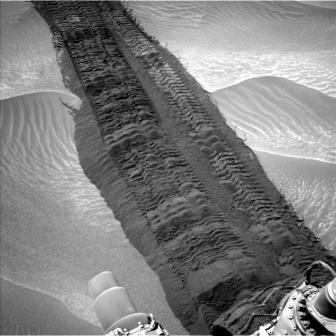
Image from NASA's Curiosity Mars rover shows wheel tracks printed by the rover as it drove on the sandy floor of a lowland called "Hidden Valley" on the route toward Mount Sharp. Photo: NASA/JPL-Caltech
WASHINGTON (PTI): NASA's rover Curiosity, the most advanced roving laboratory on Mars, has celebrated its second anniversary on the Red planet.
The unmanned spacecraft landed inside the Gale Crater on August 5, 2012 to start a multi-year mission to seek out areas where life could or may once have existed.
During its first year of operations, Curiosity fulfilled its major science goal of determining whether Mars ever offered environmental conditions favourable for microbial life, NASA said.
Clay-bearing sedimentary rocks on the crater floor in an area called Yellowknife Bay yielded evidence of a lake-bed environment billions of years ago that offered fresh water, all of the key elemental ingredients for life, and a chemical source of energy for microbes, if any existed there.
"Before landing, we expected that we would need to drive much farther before answering that habitability question," said Curiosity Project Scientist John Grotzinger of the California Institute of Technology, Pasadena.
"We were able to take advantage of landing very close to an ancient stream-bed and lake. Now we want to learn more about how environmental conditions on Mars evolved, and we know where to go to do that," said Grotzinger.
During its second year, Curiosity has been driving towards long-term science destinations on lower slopes of Mount Sharp.
Those destinations are in an area beginning about 3 kilometres southwest of the rover's current location, but an appetiser outcrop of a base layer of the mountain lies much closer - less than 500 meters from Curiosity. The rover team is calling the outcrop "Pahrump Hills."
The rover team at NASA's Jet Propulsion Laboratory in Pasadena, California, drove Curiosity across an area of hazardous sharp rocks on Mars called "Zabriskie Plateau."
Damage to Curiosity's aluminium wheels from driving across similar terrain last year prompted a change in route, with the plan of skirting such rock-studded terrain wherever feasible.
The 200 meters across Zabriskie Plateau was one of the longest stretches without a suitable detour on the redesigned route towards the long-term science destination.
Another recent challenge appeared last week in the form of unexpected behaviour by an onboard computer currently serving as backup.
Curiosity carries duplicate main computers. It has been operating on its B-side computer since a problem with the A-side computer prompted the team to command a side swap in February 2013.
In 2016, a Mars lander mission called InSight will launch to take the first look into the deep interior of Mars.
 Previous Article
Previous Article Next Article
Next Article












The Indian Air Force, in its flight trials evaluation report submitted before the Defence Ministry l..
view articleAn insight into the Medium Multi-Role Combat Aircraft competition...
view articleSky enthusiasts can now spot the International Space Station (ISS) commanded by Indian-American astr..
view article